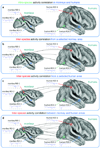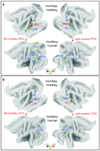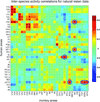Interspecies activity correlations reveal functional correspondence between monkey and human brain areas
- PMID: 22306809
- PMCID: PMC3438906
- DOI: 10.1038/nmeth.1868
Interspecies activity correlations reveal functional correspondence between monkey and human brain areas
Abstract
Evolution-driven functional changes in the primate brain are typically assessed by aligning monkey and human activation maps using cortical surface expansion models. These models use putative homologous areas as registration landmarks, assuming they are functionally correspondent. For cases in which functional changes have occurred in an area, this assumption prohibits to reveal whether other areas may have assumed lost functions. Here we describe a method to examine functional correspondences across species. Without making spatial assumptions, we assessed similarities in sensory-driven functional magnetic resonance imaging responses between monkey (Macaca mulatta) and human brain areas by temporal correlation. Using natural vision data, we revealed regions for which functional processing has shifted to topologically divergent locations during evolution. We conclude that substantial evolution-driven functional reorganizations have occurred, not always consistent with cortical expansion processes. This framework for evaluating changes in functional architecture is crucial to building more accurate evolutionary models.
Figures





Similar articles
-
Data-driven analysis of analogous brain networks in monkeys and humans during natural vision.Neuroimage. 2012 Nov 15;63(3):1107-18. doi: 10.1016/j.neuroimage.2012.08.042. Epub 2012 Aug 21. Neuroimage. 2012. PMID: 22992489 Free PMC article.
-
Establishing homology between monkey and human brains.Nat Methods. 2012 Feb 5;9(3):237-9. doi: 10.1038/nmeth.1869. Nat Methods. 2012. PMID: 22348890 No abstract available.
-
Evolutionarily novel functional networks in the human brain?J Neurosci. 2013 Feb 20;33(8):3259-75. doi: 10.1523/JNEUROSCI.4392-12.2013. J Neurosci. 2013. PMID: 23426655 Free PMC article.
-
Human cortical areas underlying the perception of optic flow: brain imaging studies.Int Rev Neurobiol. 2000;44:269-92. doi: 10.1016/s0074-7742(08)60746-1. Int Rev Neurobiol. 2000. PMID: 10605650 Review.
-
Mapping of the neuronal networks of human cortical brain functions.Adv Tech Stand Neurosurg. 2003;28:91-142. doi: 10.1007/978-3-7091-0641-9_2. Adv Tech Stand Neurosurg. 2003. PMID: 12627809 Review.
Cited by
-
Action and language mechanisms in the brain: data, models and neuroinformatics.Neuroinformatics. 2014 Jan;12(1):209-25. doi: 10.1007/s12021-013-9210-5. Neuroinformatics. 2014. PMID: 24234916 Free PMC article.
-
An open-access dataset of naturalistic viewing using simultaneous EEG-fMRI.Sci Data. 2023 Aug 23;10(1):554. doi: 10.1038/s41597-023-02458-8. Sci Data. 2023. PMID: 37612297 Free PMC article.
-
Studying the visual brain in its natural rhythm.Neuroimage. 2020 Aug 1;216:116790. doi: 10.1016/j.neuroimage.2020.116790. Epub 2020 Apr 8. Neuroimage. 2020. PMID: 32278093 Free PMC article. Review.
-
Should one go for individual- or group-level brain parcellations? A deep-phenotyping benchmark.Brain Struct Funct. 2024 Jan;229(1):161-181. doi: 10.1007/s00429-023-02723-x. Epub 2023 Nov 27. Brain Struct Funct. 2024. PMID: 38012283
-
Comparative analysis of the macroscale structural connectivity in the macaque and human brain.PLoS Comput Biol. 2014 Mar 27;10(3):e1003529. doi: 10.1371/journal.pcbi.1003529. eCollection 2014 Mar. PLoS Comput Biol. 2014. PMID: 24676052 Free PMC article.
References
-
- Nakahara K, Hayashi T, Konishi S, Miyashita Y. Functional MRI of macaque monkeys performing a cognitive set-shifting task. Science. 2002;295:1532–1536. - PubMed
-
- Vanduffel W, et al. Extracting 3D from motion: differences in human and monkey intraparietal cortex. Science. 2002;298:413–415. - PubMed
-
- Orban GA, Van Essen D, Vanduffel W. Comparative mapping of higher visual areas in monkeys and humans. Trends Cogn Sci. 2004;8:315–324. - PubMed
-
- Van Essen DC, Dierker DL. Surface-based and probabilistic atlases of primate cerebral cortex. Neuron. 2007;56:209–225. - PubMed
Publication types
MeSH terms
Grants and funding
LinkOut - more resources
Full Text Sources
Medical

